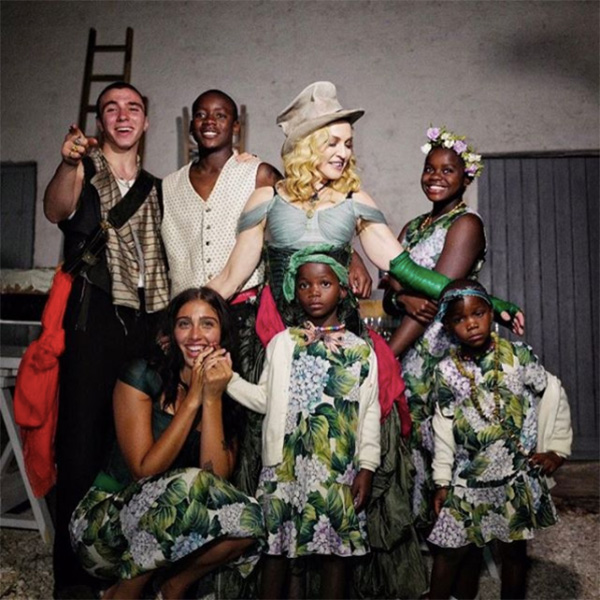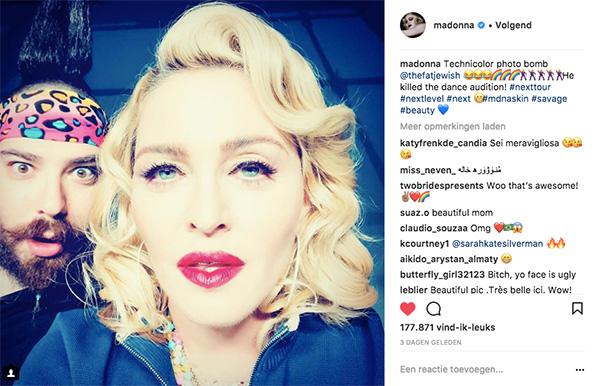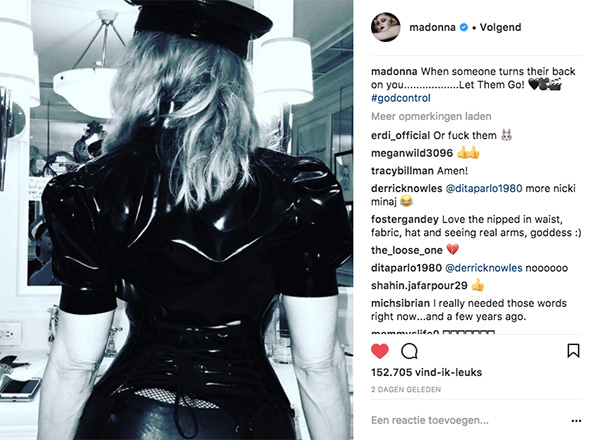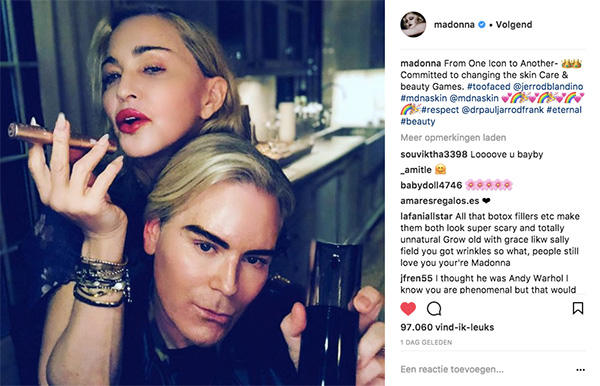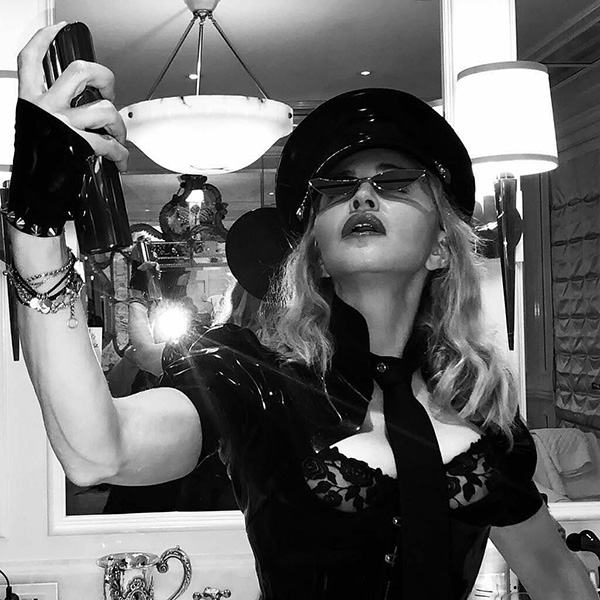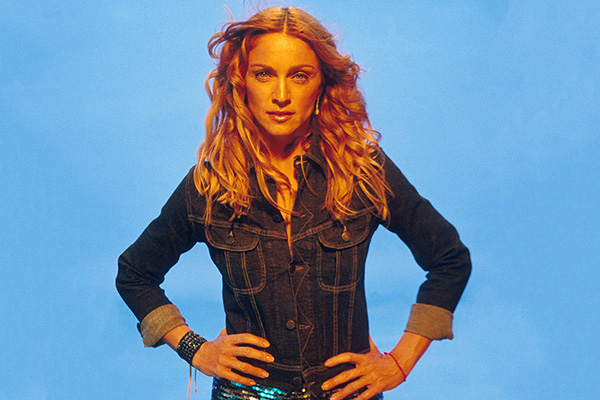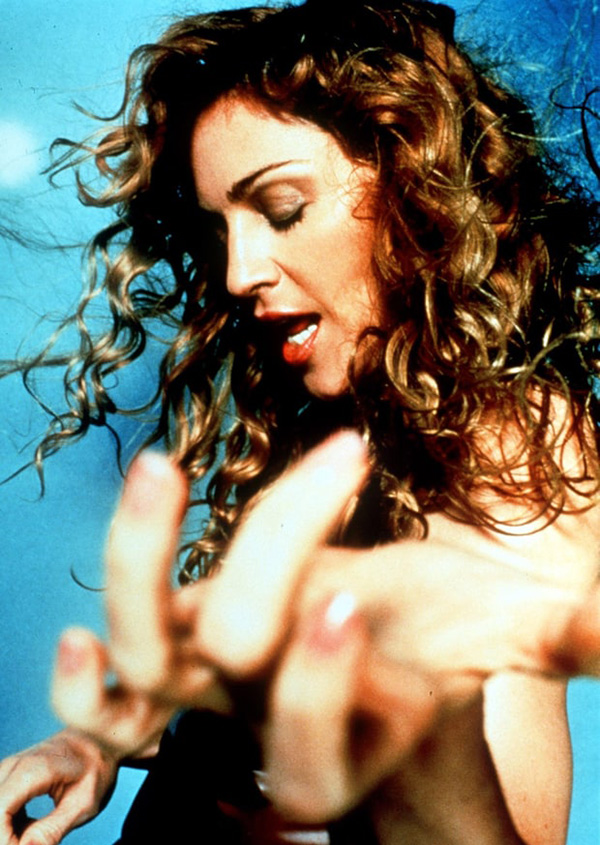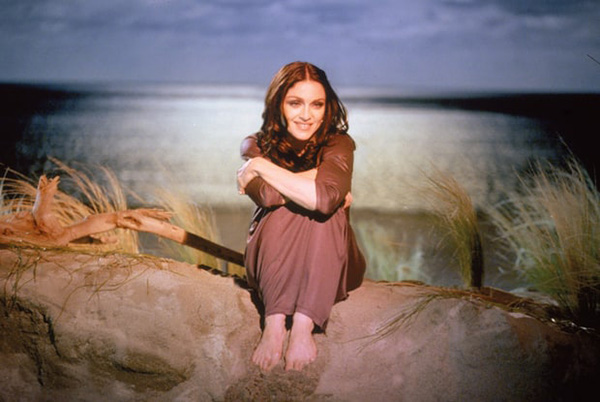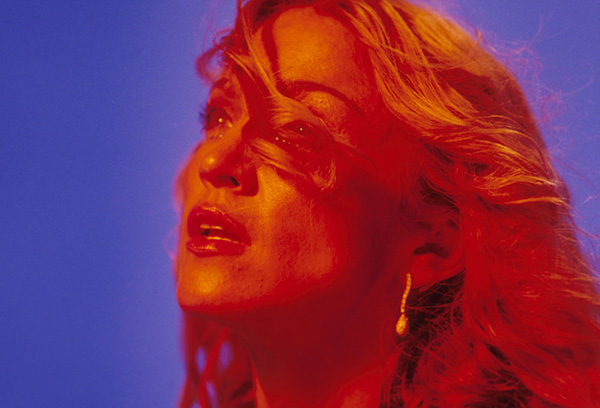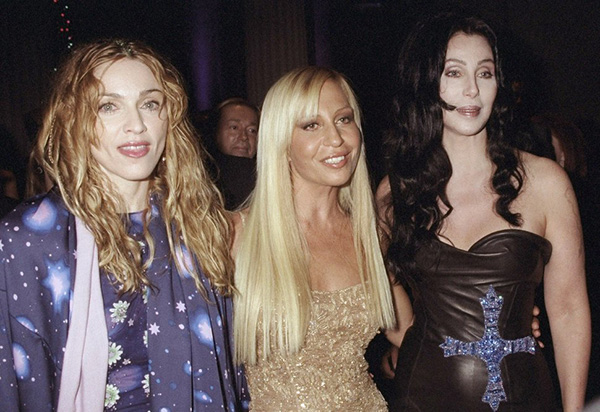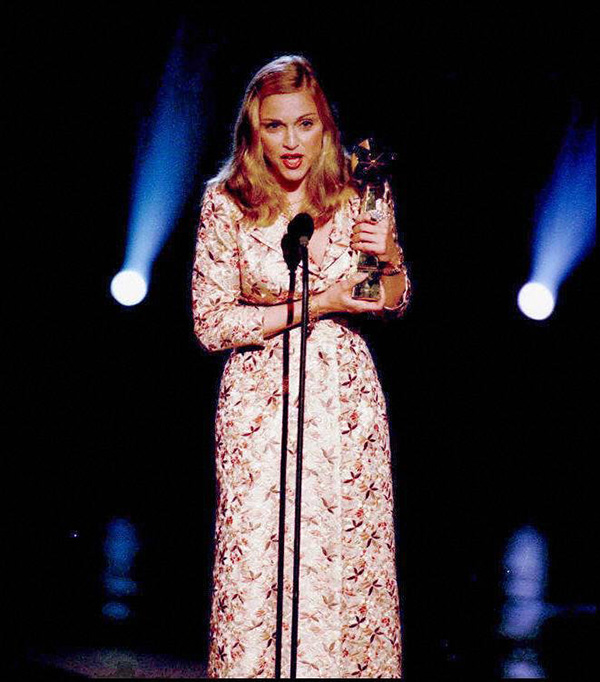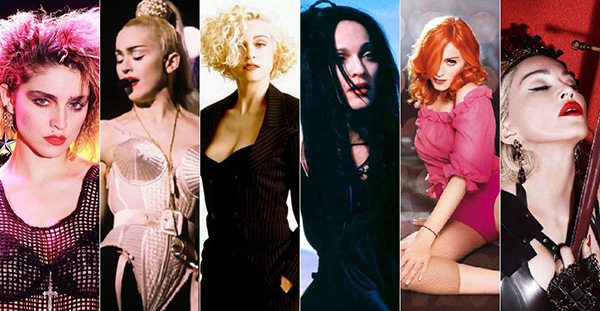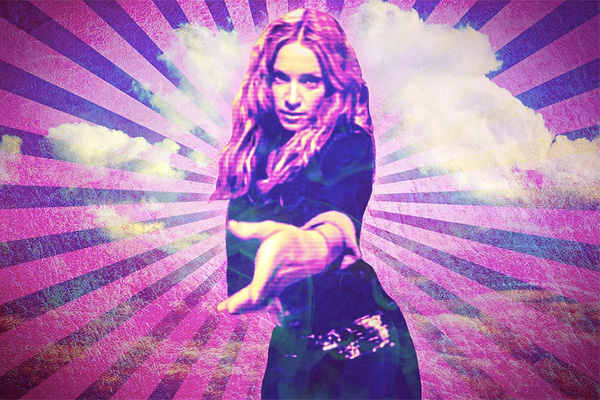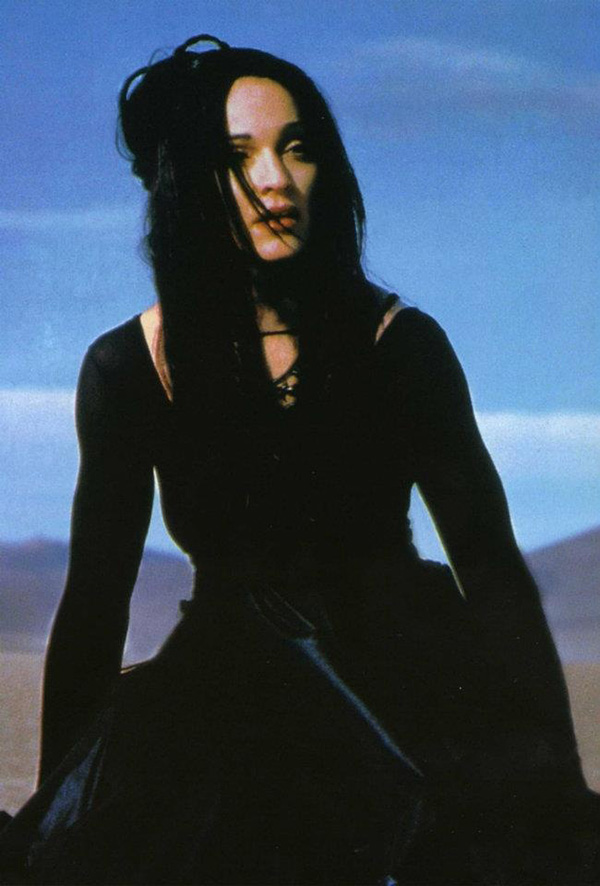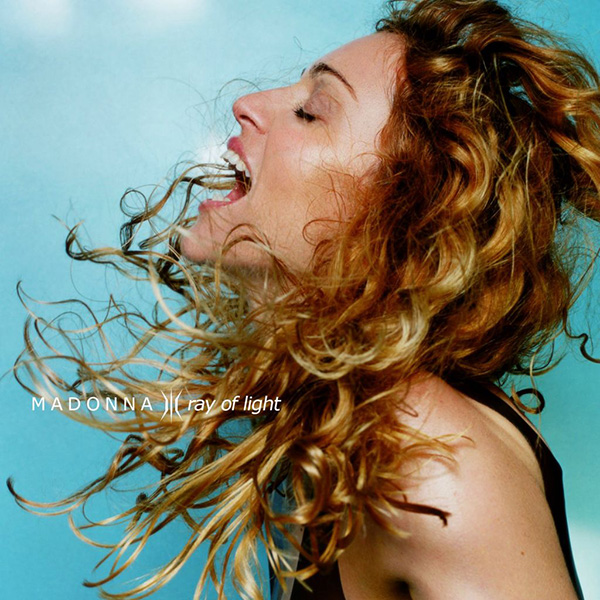| |
Madonna news - Feb. 2018
← Jan. 2018 | March 2018 →
Madonna's plotting behind-the-scenes to turn her kids into megastars ahead of pop comeback
Source: The Sun - 27 Feb. 2018The queen of pop, 59, has been secretly working and lining up her best contacts to make sure her eldest children make it big in their chosen careers
Kris Jenner coined the term "momager" after cultivating the careers of her Kardashian daughters.
But she will have some stiff competition on her hands now that one of my favourite pop stars Madonna is on a mission to make children megastars too.
I can reveal the queen of pop is secretly working behind the scenes to give her four eldest kids an extra push in the right direction to make it big in their industries.
She has set herself the task of masterminding daughter Lourdes Leon's dance dreams, son Rocco Ritchie's future in art, David Banda's bid to be a footballer and Mercy James' ambition to be the a female Kanye West.
A source close to the star revealed: "Madonna adores every single one of her children and wants to use her influence to build them incredible careers.
"Lourdes wants to train as a professional dancer. She will start to focus on dance properly as she graduates from her musical theatre course at university in America soon.
"Rocco is a keen painter and is inspired by Banksy.
"His dream is to showcase his work at an exhibition. Madonna is already lining up the best contacts for him in London's art scene.
"Her adopted daughter Mercy idolises Kanye and is already writing raps and performing them while Madge moved to Portugal this year in support of David's dream to become a footballer."
But focusing on her children, doesn't mean she's given up on her own career.
Insiders say Madonna is planning to record a new track and even go on tour.
A source added: "She has been in the studio for months. She wants to release new music towards the end of this year."
Madonna has so far left five-year-old twins Esther and Stella out of her plan for stardom.
"I'm all for her helping out her kids as long as she doesn't forget her own pop career."
Madonna criticizes songwriting process in today's music industry
Source: Instagram - 26 Feb. 2018An Instagram in which manager Guy Oseary celebrated the 20th anniversary of Ray Of Light has turning into quite a surprising thread after Madonna herself commented on it.
Oseary posted part of the famous interview by MTV's Kurt Loder, during the recording of the iconic 1998 album, and suggested Madonna should some day do a tour specifically for this album (much like U2 did for The Joshua Tree last year).
In the comments section, Madonna posted what seems like a dig at her manager and the songwriting process that is forced upon her:
- madonna Can you help me now please!! 😂
- madonna Remember when i made records with other artists from beginning to end and I was allowed to be a visionary and not have to go to song writing camps where No one can sit still for more than 15 minutes................🔥🔥🔥🔥🔥 coming soon
Fans responded massively to M's comments, begging her to consider going back to her roots, when she recorded entire albums with just 1 or 2 producers, such as Steve Bray, Patrick Leonard and William Orbit.
In the past decade, Madonna has had multiple songwriters and producers work on her releases, as this is the way most artists work these days. It remains unclear so far whether the process for the new upcoming album will be any different.
A post on her Instagram later today seemed to respond to the many reactions on her comments.
Madonna films another MDNA Skin ad
Source: Instagram - 26 Feb. 2018Over the past few days, Madonna and some of her collaborators have posted pictures and videos of the filming of a new commercial for MDNA Skin. Also on set were The Fat Jew, dermatologist Paul Jarrod Frank, and Jerrod Blandino from Too Faced Cosmetics.
Madonna's 'Ray of Light' at 20: her collaborators look back on the electronic pop milestone
Source: Billboard - 24 Feb. 2018When Ray of Light dropped on Feb. 22, 1998, the world was already used to the idea of Madonna reinventing herself with each album. But even so, the Madonna Ciccone revealed on Ray of Light was a breathtaking departure from everything that had come before. Instead of pushing boundaries and pressing society's buttons with the smirk of a precocious child, the then-39-year-old singer was looking inward -- and for the first time, she was admitting she didn't necessarily like what she saw. For a pop star and songwriter defined by her ferocious confidence, Ray of Light showed us that after conquering the world, Madonna still had doubts.
"I traded fame for love, without a second thought / It all became a silly game, some things cannot be bought," Madonna intones at the start of the album over an impossibly lonely ambient soundscape. "I got exactly what I asked for / Wanted it so badly / Running, rushing back for more, I suffered fools so gladly / And now I find, I've changed my mind."
While Madonna's previous studio album kicked off in a similar navel-gazing fashion, Bedtime Stories' opener "Survival" was all about resilience and perseverance. "Drowned World/Substitute for Love," however, finds Madonna sounding dispirited and dissatisfied with what she's become (hey, did you expect a song with TWO depressing titles to be an exuberant dance anthem?). But Madonna being Madonna, that doesn't translate into self-pity -- instead, it's a jumping off point for her evolution in both sound and spirit, brilliantly setting up the narrative of the most contemplative album of her career. On Ray of Light, she's reached the top, but she's still empty -- and she's wondering what's next.
Over the course of 13 tracks, Madonna takes us through her journey to self-realization, touching upon Eastern philosophy ("Sky Fits Heaven"), yoga ("Shanti/Ashtangi"), the birth of her first child, Lourdes ("Little Star"), regrets over her past ("Candy Perfume Girl"), and lost love ("The Power of Goodbye"). Of course "Ray of Light" remains one of the most joyous entries in her catalog, but the bulk of Ray of Light is marked by introspection. And significantly, the album's minimalist closing track, "Mer Girl," offers no answers or solutions as Madonna confronts mortality and a life haunted by her mother's death: "I ran and I ran, I was looking for me… I ran and I ran, I'm still running away." On Ray of Light, the sagacity is Socratic -- Madonna doesn't have the answers, but she knows it; and that's what makes this her wisest work to date. (And that maturity wasn't just lyrical: Thanks to the rigorous vocal training she'd taken to hone her craft for her Golden Globe-winning role in Evita, Madonna's vocal control had never been more nuanced and full-bodied.)
If Ray of Light was a surprise left-field turn for listeners, one longtime collaborator didn't seem to notice any glaring changes in her behavior when working on the album. Patrick Leonard, who started working with her for her 1985 Virgin Tour and would go on to co-write and co-produce well over a dozen Madonna hits including "Live to Tell," "Like a Prayer," and "Cherish," found the songwriting process for Ray of Light to be fairly similar to what they'd done before.
After sitting out the Erotica and Bedtime Stories LPs, Leonard tells Billboard Madonna reached out to him with a simple proposition: "The premise was, 'This (partnership) worked really well before, let's try it again.' It was just that, it was kind of innocent. If it goes well, we'll do it, and if it doesn't, fine...When you do that much collaborating, you just fall right back into it." For Ray of Light, the process yielded several new songs: the reflective "Sky Fits Heaven," the philosophic banger "Nothing Really Matters," the pulsating "Skin" and the massive hit "Frozen." (He also co-wrote the Japanese bonus track "Has to Be," but admits to barely remembering it: "I did work on it?" Leonard says with a laugh. "Well, that's nice.")
If the songwriting process was familiar, Leonard did, however, notice a change in her literal voice: "The one thing I noticed when we were doing Ray of Light is her singing. She was in a slightly different place singing-wise because of Evita, and I think that influenced some of this stuff for her. There had been a lot of focus on singing for her, and it changed things, but not better or worse, just different."
Although Ray of Light was his first time writing songs with Madonna, songwriter Rick Nowels -- who met her at the Upper East Side Barneys in Manhattan the evening of Clive Davis' 1997 Grammys party -- gives an account of working with her that resembles what the lion's share of her collaborators say: She's fast, and excessively professional.
"I had a little house up in Mulholland Drive (in Los Angeles) and I had a studio in it, it overlooked the San Fernando Valley," Nowels says of their writing sessions. "I sat behind the keyboard and she sat opposite me in the living room. And every day she'd show up 3-7: She was always on time, always arrived at 3 and always left at 7. We'd start with nothing and she'd walk out at the end of the day with the song demoed and the vocals cut... I'd start playing and she'd start singing, and these songs happened quickly, maybe a half hour, 45 minutes."
Over the course of two five-day work weeks, the pair wrote nine songs. Three of them -- "The Power of Goodbye," "To Have and Not to Hold" and "Little Star" -- ended up on Ray of Light, with another one, "Like a Flower," going to Italian singer Laura Pausini (recorded in Italian under the title "Mi Abbandono A Te").
Those songs followed a directive Madonna had given Nowels prior to their sessions as he was workshopping beats: "She said prepare stuff 'either really radical or really beautiful…nothing in between.'"
You could apply both of those descriptors to one of Madonna's Ray of Light tracks with Patrick Leonard, the Billboard Hot 100 No. 2 hit "Frozen." Gossamer and gorgeous on the verses but inventive and CinemaScope-sized on the chorus, Leonard recalls Madonna's specific instructions for that song: "She asked me if I could write something that was somewhere between The English Patient and Nine Inch Nails, and that's what 'Frozen' was."
If the songwriting process on Ray of Light didn't veer too far from her previous writing sessions, her choice in producers did make an enormous difference. After abandoning a plan to reteam with "Take a Bow" collaborator Babyface, Madonna turned to British techno veteran William Orbit -- whose Strange Cargo series she was a fan of -- to produce all but one of the album's 13 songs, and producer/composer Marius de Vries to co-produce three tracks.
"I knew it was extraordinary straightaway," says de Vries, who had previously worked with Madonna on Bedtime Stories and her Massive Attack collaboration "I Want You" (a Marvin Gaye cover). "William obviously has a very strong sound of his own, and it was coupled with her newfound confidence in both the songwriting and singing departments. Even from the early stages, I wouldn't say I knew it was going to be a groundbreaking commercial success, but I thought it sounded fascinating, compelling and creatively energized."
Orbit's adventurous soundscapes and ambient textures gave the album a chilly cohesiveness. While Leonard did co-produce his four Ray of Light songs, he admits his presence was less involved than usual. "The other records we very much produced together, and on Ray of Light I was just watching a little bit," he recalls. "It was pretty clear William was doing something very special and not something I would have done – it's not my wheelhouse. He works very uniquely. He has an impressive vision, for sure. At the end of the day, there wasn't anything I didn't like."
Similarly, Nowels describes how Orbit used his demos with Madonna as "templates for his production," noting that "'The Power of Goodbye" was altered considerably. "Some of the chords changed and the feel of the song changed…. The demo got leaked online so you can hear the original. It was a No. 1 song in Europe. I love both versions, to me it is among her best songs."
"I let William (Orbit) play mad professor," Madonna told Spin for a 1998 cover story. "He comes from a very experimental, cutting-edge sort of place — he's not a trained musician, and I'm used to working with classically trained musicians — but I knew that's where I wanted to go, so I took a lot more risks."
But for one of the biggest pop stars on the planet, the risk-taking stage can't last forever.
"They were in full-on experimental mode," de Vries says of joining Orbit and Madonna in Los Angeles to complete the album. "William, if left to his own devices, will keep generating ideas because he's first and foremost a profoundly creative soul. With the wealth of material they had they were maybe in need of a little perspective, and possibly I might say, discipline in the final stages." And it was an easy fit for him. "William and I come from the same generation and background, late '80s and '90s U.K. electronica. We already spoke the same language -- it wasn't a stretch for me to fit into that aesthetic, and it was easy for me to recognize that and protect it."
When de Vries hit the studio, two of his co-productions were already well underway. "'Nothing Really Matters' and 'Little Star' I had a really good head start on, I'd spent a couple weeks messing around with them in my studio near Cambridge.... finishing them off was relatively straightforward," he notes. And while he didn't co-produce it, he also contributed to one of the album's signature songs, helping push it over the finish line.
"('Frozen') wasn't finished and Guy (Oseary, Madonna's manager) in particular felt it was going to be a key track. Guy took me aside and said 'Look, there's a lot of cooks in this production kitchen already but it's not quite finished.' I took a day or two finessing and adding to some of the drum programming and making some additional textures for it. I love the song, and it turned out to be such a key track in making the album global, though perhaps at the time it didn't scream 'obvious hit' for me. But in the end I was just happy to contribute."
Leonard, who co-wrote and co-produced "Frozen," shared a similar sentiment when asked if he knew it would be a breakout. "When you're writing something, in my career, the word hit never comes into it. You just can't say that word. Bad word to say."
For de Vries, working on the driving "Skin" was "the most collaborative from the ground up" song on Ray of Light. The U.K. producer recalls adding a little Easter egg to that song via a field recording he'd taken in the Marrakesh marketplace Jamaa el Fna while on holiday with his kids: "If you listen very carefully to the tail of the fade on 'Skin,' you can hear my son -- who was maybe five at the time -- saying, 'Daddy are they snake charmers?'"
Kiddie cameos aside, Madonna didn't turn to Orbit and de Vries for their sweetness. Talking to Spin in 1998, she explained why she tapped the U.K. electronic producers for her seventh LP: "They bring the cold. I bring the warmth."
Nowhere is that combination of daring production and vocal depth more apparent than on the title track (speaking of bold, the original version of "Ray of Light" exceeded 10 minutes until it was edited down.) A towering achievement in her discography and '90s music in general, "Ray of Light" helped introduce techno (already popular in Europe) to the top 40 in America, cracking the door open for an eventual electronic music revolution in U.S. pop.
But "Ray of Light" is more than just Madonna's foray into electronica. As she told Spin, there's a warmth she brings to the then-burgeoning genre -- few electronic albums prior to Ray of Light display moments of radiant joy along the lines of "Ray of Light." It bursts with the ecstasy of a new day and new possibilities, conveying the sense of a fresh start that's still true to oneself. And a testament to her underrated talent as a songwriter, the lyrics on "Ray of Light" (partially based on the 1971 folk song "Sepheryn" from Curtiss Maldoon) are never cloying or pandering. What might have come across as Chicken Soup for the Raver's Soul in the hands of a lesser talent becomes a transcendent, inspirational declaration of intent from the pen of Madonna Veronica Louise Ciccone.
"It's an iconic album. It's Madonna in all her artist glory. William had a revolutionary energy in his record making and I think they inspired each other," Nowels says. "I feel personally honored to have had a small role in her musical story."
"The whole album, not just the material I worked on, has an undeniable identity to it. You can play a second of it and you'd immediately know where you were and what album you're in," de Vries says. "That's probably one of the reasons for its longevity and position in people's favorite records list -- it's unmistakable. A huge tip of the cap to William Orbit, he should look back on this as a titanic achievement."
"(Madonna and I) collaborate together well and I've always held to the mutual respect we have for each other; we worked fast and easy," Leonard recalls. "There was a couple things (on the album) I thought didn't get the kind of attention they should have, but right now, what I know about this process, if I listened to it right now, those things that I didn't feel that way might be my favorite things. It's too subjective and it changes with time."
Ray of Light would hit No. 2 on the Billboard 200, moving 371,000 copies in its first week; it earned her four Grammys and went on to sell 3.89 million copies in the U.S. (through Feb. 15, 2018) according to Nielsen Music. Just days ahead of its 20th anniversary, its ongoing relevance to pop culture was underlined when Belgian figure skater Loena Hendrickx performed to "Frozen" at the 2018 Winter Olympics in PyeongChang. "It's a powerful song," Hendrickx told Billboard. "Madonna is someone I look up to because of her strong personality and the goals she accomplished. She is an awesome example of girl power."
But beyond numbers and Olympic appearances, Ray of Light is a laudable rarity in pop music: It's an album that demonstrates how true happiness starts with tough self-examination, and that the path to strength lies in acknowledging your regrets and weaknesses without letting them define you. Madonna would reach higher positions on the albums and singles chart after this, but never again would a dance-pop LP, from her or another, sound so wise.
Madonna's 'Ray of Light': 6 things you didn't know
Source: Rolling Stone - 24 Feb. 2018Twenty years ago, Madonna was at a crossroads. After launching her Maverick entertainment company in 1992 with her widely but not wisely panned Erotica album and Sex book, the star entered a period of relative caution. The exuberant queerness of those works gave way to muted ballads, followed by Evita, which made her feminism palatable to Middle America. After the birth of her daughter Lourdes in 1996, she sought spiritual enlightenment in Kabbalah and Ashtanga yoga, and immersed herself in the work of songwriters who shared their secrets via meditative electronic textures – particularly Björk, Everything But the Girl and Tricky.
All these factors shaped Ray of Light, an album akin to those artists' work, but also uniquely Madonna-esque. Rooted in the underground yet heard and loved by millions, it's the multi-platinum antecedent to today's popular EDM, but considerably more personal. Twenty years later, singers and producers alike are still chasing its finely finessed fusion of anguished rumination and beat-driven bliss. Rolling Stone spoke with key collaborators on this watershed LP. Here are six things we learned.
1. Although the project's synth-centric final results earned her the passing nickname Veronica Electronica, Madonna didn't initially plan to work with songwriter Rick Nowels or producer William Orbit.
After Evita, Madonna reunited with Babyface, co-producer and co-writer of Bedtime Stories' "Take a Bow," which had topped the Hot 100 for seven weeks in 1995. But according to the smooth-soul magnate, "Madonna didn't want or need to repeat herself." Spotting her at Barney's department store when he'd come to Manhattan for the Grammys, producer and songwriter Rick Nowels – now Lana Del Rey's primary collaborator – impulsively introduced himself. "I told her I was nominated for a Grammy for Celine Dion's 'Falling Into You,'" he recalls. Much to his surprise, she replied, "Oh, I love that song." This led to a meeting at her home, where, according to Nowels, "She said she had no idea what the new album was going to be." At Nowels' Mulholland Drive home studio, the pair wrote nine songs in 10 days.
"Until then, I had only written with friends – Ellen Shipley, Billy Steinberg, and Stevie Nicks," Nowels remembers. "It was quite unnerving to write one-on-one with the biggest star on the planet. But I loved her songs and felt an emotional kinship with her music. I got a lot of DJ records and old film score records and prepared loops to write to. Once the song was written, we'd drop the loop and program our own beat. 'Little Star' and 'The Power of Good-Bye' were written over a drum 'n' bass rhythm, which was happening at the time. 'To Have and Not to Hold' was written to a bossa nova beat."
Guy Oseary – chairman of Maverick Records – phoned synth-pop veteran William Orbit, who'd previously remixed Madonna's "Justify My Love" and "Erotica." Orbit's involvement expanded as the project evolved, although core Madonna associate Patrick Leonard and British producer Marius De Vries were both called in to assist as the album's creation stretched out over four-and-a-half months – an eternity for the fast-working Madonna.
2. Ray of Light is largely about spiritual transformation, but one song deals with the perils of hard drugs.
"Candy Perfume Girl" came out of a two-week writing and recording stint between Orbit and Susannah Melvoin, daughter of top L.A. session musician Mike Melvoin, brother to late Smashing Pumpkins touring keyboardist Jonathan Melvoin, twin sister to Prince and the Revolution's Wendy Melvoin, and former fiancée to Prince. She's no slouch herself: As member of the Family, a splinter group of the Time, she co-sang the original version of "Nothing Compares 2 U" and co-wrote one of Prince's sweetest songs, Sign o' the Times' "Starfish and Coffee." According to Melvoin, William Orbit offered her some tracks to write melodies and lyrics to and sing over for what she thought would either become her solo debut or an album by Orbit's Strange Cargo project, which she – and, it turns out, Madonna – both loved.
"I was on the floor [of Orbit's studio], just putting words together, and came up with 'Candy Perfume Girl,'" she recalls. "It was a personal track for me. At the time, I was mourning my brother [Jonathan died of a heroin overdose in 1996], and it was the allure of drug addiction. I was pretty jacked up about that record happening, and there were a couple of other songs that I had done with him there."
But Melvoin's publisher got a call notifying her that Orbit had offered Madonna the tracks they'd worked on: "Candy Perfume Girl" was going on the record, and Madonna wanted a third of the publishing. Melvoin maintains she also wrote the original lyrics to Ray of Light's "Swim," which, she says were "changed, but not significantly," as well as the original melodies, which she concedes were "manipulated." Yet in this case Melvoin didn't get credit or compensation. The songwriter emphasizes she has no beef with Madonna; she feels the superstar understood exactly what "Candy Perfume Girl" was about, and that she made a brilliant record. "But had I gotten proper publishing on Ray of Light," Melvoin asserts, "I wouldn't be worried about my financial life."
3. The album's defining techno-rock title track was based on an obscure folk oldie.
Just as Orbit offered Madonna his Melvoin material, he similarly sent her a tape featuring unreleased work with Christine Leach, an English singer who'd co-written and sang with Strange Cargo. Leach's uncle is David Atkins, who, as Dave Curtiss, had been half of Curtiss Maldoon, an overlooked folk duo that released a pair of unsuccessful albums on Deep Purple's label in the early Seventies. The first one yielded "Sepheryn," which Leach altered and sang parts of over the instrumental track given to her by Orbit, who had assumed Leach solely wrote what she sang. Madonna made additional changes, and the track became what we know as "Ray of Light," which is credited to Madonna, William Orbit, Clive Maldoon, Dave Curtis [sic] and Christine Leach.
Some elements "Ray of Light" are strikingly similar to parts of "Sepheryn": The opening vocal melody remains basically the same while the lyrics deviate only slightly. But "Ray of Light" omits the multiple tempo changes of "Sepheryn" while maintaining a steady rhythm. These changes appear in the Leach rendition leaked online. Madonna's interpretation – which adds a crucial second, goddess-centric verse – is certainly closer to it than to the Curtis Maldoon original, but Madge's way with the melody commands and sustains attention in ways that Leach's does not. Madonna and Orbit managed to turn a compelling experiment in transformation into the cornerstone of a whole album about radical personal and spiritual growth.
4. Despite the borrowing, Madonna's Ray of Lightcollaborators consider the icon to be a top-level musical mind.
Having co-written and co-produced significant chunks of many Madonna albums, including Ray of Light, as well as serving as her keyboardist and musical director on two major tours, Patrick Leonard has worked with Madonna longer and more extensively than any other musician. He also co-wrote and produced Leonard Cohen's final three studio albums, so when he calls her "a helluva songwriter," it means something.
"Her sensibility about melodic line – from the beginning of the verse to the end of the verse and how the verse and the chorus influence each other – is very deep," he contends. "That's not common. Say 'Live to Tell,' for example, our first big single. The melodies I wrote are still there and she sings them for the most part, but it's where she departs from them that turned it into a song. Many times she's singing notes that no one would've thought of but her. Some of it can be perceived as naiveté because she's picking a note you wouldn't choose. But who needs the 'correct' note? You need the right note that tells the story, and she's great at that. She certainly made me look better. All I have to do is look at all the other people I wrote with over the years and how that went."
Los Angeles-based cellist Suzie Katayama has worked with many big names in rock and pop including Roy Orbison, Neil Young, Prince, Eric Clapton, Björk and Beck. Her association with Madonna goes way back to 1986, and for Ray of Light, she conducted its strings and woodwinds – 20 violins, six violas, six cellos, four basses, two flutes and an oboe.
"It was a long day," she recalls. "For that album, we did the orchestra in one day, both 'Frozen' and 'The Power of Good-bye.' That's why I don't remember much except for working really hard and fast. Everything that Madonna does, she is there. I have never been to anything that's hers that she didn't have the final say on it. She's hands-on. People can say whatever they want, but I remember when she did Dick Tracy, I had never seen anyone work so hard. I was impressed, and I think everyone was because she had to hold her own with a lot of people in that movie.
"This was the record where I had more people calling me, saying, 'Whoa, this is a great record,'" she continues. "It was real musical. Ray of Light showed a side of her that I don't think most people saw."
5. One of the songs written but not recorded for Ray of Light was released years later by an Italian superstar.
If you're not European or don't listen to Spanish-language radio, you probably don't recognize the name Laura Pausini. But the Faenza-born singer is pretty much a household name overseas, having sold more than 70 million records internationally. Her attempt to crack the U.S. market, 2002's From the Inside, flopped spectacularly. So for 2004's Resta in Ascolto and its European equivalent Escucha, Pausini returned to Italian and Spanish respectively, and together those albums sold more than 5 million copies, while the latter snagged both Grammy and Latin Grammy trophies. According to Nowels, their closing song, "Mi Abbandono a Te" ("Me Abandono a Ti" on Escucha) was originally titled "Like a Flower," and was composed by both him and Madonna during their Ray of Light songwriting sessions. Having re-written most of the Nowels-produced ballad's lyrics in Italian and Spanish, Pausini makes it her own. Nevertheless, the melody's melancholy Ray of Light–ness remains: The bilingual chorus couldn't be more Madonna if it poked you in the eye with a pointy bustier.
6. None of Madonna's records won a Grammy until Ray of Light.
The Recording Academy often rewards entertainers who release hit after hit, but this hasn't been the case with Madonna for much of her long career. In her first 15 years of releasing albums, she got a few scattered Grammy nominations – including nods for "Crazy for You," "Papa Don't Preach," and "Who's That Girl" – but her only win was for Blond Ambition World Tour Live, a long-out-of-print 1990 laser disc that's never been officially reissued on DVD or any other format.
But Ray of Light significantly interrupted her losing streak: It won for Best Dance Recording and Best Pop Album, and the title track's promo clip won Best Short Form Music Video. Since then, she's won three more times out of 15 subsequent nominations – including Best Electronic/Dance Album for her 2005 LP Confessions on a Dance Floor, which features a kindred mix of rhythmic extroversion and poetic reflection.
Rather than throwing the Academy some deserved shade, Madonna, taking the stage in a flaming red Jean-Paul Gaultier kimono, merely thanked her collaborators before she yanked William Orbit – who towered shyly above her – down and toward the mic, chiding him for mumbling his gratitude: "He does speak English; you'd never know it."
What Gianni Versace's death tells us about Madonna's 'Ray Of Light' renaissance
Source: Huffington Post - 23 Feb. 2018The singer was recording the album when Donatella Versace called to say her brother had just been murdered. The rest is 20-year-old history.
"Traveling, traveling / In the arms of unconsciousness," Madonna cooed on the Björk-assistedsingle "Bedtime Story," released in 1995. Overexposed and castigated after the ruckus surrounding "Erotica" and the carnal coffee-table book Sex, she'd forged a reverie about disconnecting from reality. "Today is the last day that I'm using words / They've gone out, lost their meaning."
But by 1998, Madonna had awoken again. On "Sky Fits Heaven," the seventh track from the enlightened electro-rock masterpiece "Ray of Light," she repeated a familiar phrase ― except here it ended on an upbeat: "Traveling, traveling / Watching the signs as I go." This time, pop music's doyenne of reinvention was anything but unconscious.
Her footpath from the "Bedtime Story" era to "Ray of Light," which turns 20 on Feb. 22, places Madonna at the nexus of celebrity culture circa 1997 (when she spent five months writing and recording the album) and early 1998 (when she released and promoted the album, which went on to win three Grammys and six MTV Video Music Awards). Nearing 40 and competing with a fresh generation of A&R-packaged teenyboppers, Madonna had risked aging out of mainstream stardom, one of the many sectors of society that isn't kind to mature women. Instead, the ambient fizzes and mystical flurries on "Ray of Light" formed a cutting-edge benediction that rehabilitated Madonna's image ― a coup few legacy acts could hope for today. She was a new mother, animated by Kabbalah and Ashtanga yoga, but uninterested in maternity leave.
Madonna's late '90s eminence can be further distilled through one morsel about the creation of "Ray of Light," her seventh studio disc: On July 15, 1997, the day she recorded the gritty meditation "Swim," Donatella Versace called Madonna to report that her brother Gianni had been shot outside his Miami mansion.
William Orbit, the English producer who helped shape "Ray of Light," has related this anecdote at least twice. The first time was in 1998, during an interview with Music Week.
"The day she [recorded 'Swim'] she got a call on the way to the studio that her next-door neighbor Versace had been murdered," he said. "Lyrically it was written before that, but it is topical."
And again in 2002.
"We were recording 'Swim' on the day Versace was murdered," Orbit told Q magazine. "Madonna was very friendly with him and his sister, Donatella, who was in the street, distraught, on her cellphone to Madonna. But she did the vocal, which is probably why it has such an emotional impact."
Earlier this month, I emailed Orbit to ask for more details. "There's quite a story around that," he confirmed, declining an interview in the same breath. Representatives for Madonna and Donatella Versace did not respond to my inquiries.
Madonna was famously chummy with the Calabria-born Versaces, first posing for their fashion line's ad campaign in 1995 when, as Orbit indicates, she and Gianni both owned townhouses on 64th Street in Manhattan (though they weren't next door to each other). A month and a half after recording "Swim," she penned the couturier's eulogy for Time magazine, recalling, among other lavish details, the days she borrowed his well-staffed Italian villa. "I've got a pocketful of memories in my Versace jeans, and they're not going anywhere," she wrote.
On the surface, as it relates to "Ray of Light," Versace's murder at the hands of spree killer Andrew Cunanan ― also chronicled in the ongoing season of Ryan Murphy's stirring FX series "American Crime Story" ― is an ill-timed coincidence. Madonna didn't compose "Swim" in response to Versace's death, but she had to perform it ― an anthem about the world's "sins" ― on the day one of her most famous friends informed her that another of her most famous friends had lost his life. Madonna grieved in the studio, just like you or I must still show up to the office after awakening to bad news.
These events positioned her, however privately, at the center of an international tragedy ― just as she was throughout the AIDS crisis, when, for example, she crafted the "Erotica" balled "In This Life," dedicated to her longtime chum and collaborator Martin Burgoyne, who'd died from the disease in 1986. Of all people, Donatella thought to call Madonna, a celebrity among celebrities, with the news of her brother's scandalous death.And what episode of Madonna's career better fits that narrative than the one dedicated to her spiritual fortification?
"Put your head on my shoulder, baby / Things can't get any worse / Night is getting colder / Sometimes life feels like it's a curse," Madonna croons on "Swim," which opens with a melancholic serenity and settles into a guttural anger that's impossible to underestimate even without knowing Madonna's mood on the day of its recording. "Swim" is one of the few "Ray of Light" tracks that doesn't offer a glimmer of Zen in its heady rumination, so Madonna instead follows it with the glittering title song, whose lyrics become a salve: "Zephyr in the sky at night I wonder / Do my tears of mourning sink beneath the sun? / ... / She's got herself a little piece of heaven / Waiting for the time when Earth shall be as one."
Life will go on, despite the country's anger at her provocations, despite Versace's demise, despite the fact that the music industry is stacked against luminaries reaching arbitrary sell-by dates after being crowned American royalty when they were dewy teens or 20-somethings. (To that last point: Madonna had a Top 10 hit as recently as 2012. She was 54! Almost none of her peers can claim that feat at such an age.)
In fact, the entirety of "Ray of Light" feels like a renewal following some kind of death ― a tangible loss of her youth, a fleeting sense that her yearning to get into the groove had faded. (It would soon return, of course, because Madonna is nothing if not an expert in brand management.) That's why her existential primping ― "Nothing takes the past away / Like the future / Nothing makes the darkness go / Like the light," she sings on "Nothing Really Matters" ― further acts as a metamorphosis. Her interior life was laid bare, and the results were an extended tone poem.
But here's something else that strikes me about this album: Even with a track that morphed into a response to a fellow artist's death, Madonna didn't find it as personal as the rest of us did. Because its lyrics were more sophisticated than, say, "Holiday" or "Lucky Star," the fawning reception implied that the dance-floor invitations on which she'd built her career were too fluffy to be taken seriously ― a tired, vapid, persistent appraisal of female-fronted pop.
"But my other albums were personal too," she told Spin magazine in a 1998 cover story. "'Bedtime Stories' was personal, believe me. 'Erotica' was personal. Maybe I'm a better writer now. I hope so. I think on my last few records I've been operating from a place of anger and frustration and bitterness and feeling like a victim and being very defensive. I don't feel that way right now."
This quote mirrors something Madonna said when I interviewed her about her most recent album, "Rebel Heart," in 2015: "A lot of people say, 'Oh, you've written so many personal songs on this record,' but I think that I wrote a lot of personal songs on my last record, ['MDNA'], but people didn't pay attention to it. But anyway, it's OK. Things happen for a reason."
It's verification that Madonna must forever prove herself, that because she is a woman who came to New York as a classically trained dancer chasing fame, her songwriting will often be denied the gravity afforded of her male counterparts. But the Versace tidbit tells a deeper story: the story of someone around whom the ebbs and flows of mass culture orbit, and who poured her own evolution as a human being into her contributions to that culture.
It's as if everything Madonna had done, artistically and commercially, had been leading to "Ray of Light." She was more conscious than ever before.
Ray Of Light turns 20: a track-by-track review
Source: Attitude - 19 Feb. 2018Matthew Barton looks back at one of the Queen of Pop most career-defining records.
In 1997, Madonna was at a career crossroads. She had just turned in an acclaimed performance in the film version of Evita, was a new mother to daughter Lourdes… and hadn't released a new album of original material for nearly three years.
The bold and brazen sexuality of 1992's Erotica and its sister "coffee table" photobook, Sex, threatened to derail a career that had been in the firm ascendancy since 'Lucky Star' broke Madonna out of New York City's underground dance scene in 1983.
1994's low-key R&B LP Bedtime Stories, 1995's ballads collection Something to Remember, and 1996's Evita clawed back some of the credibility unfairly lost during the Erotica era by dialling down the sexual bravado, but just who was Madonna in 1997? What did she have to say? Where else was there left to turn?
It seemed that Madonna herself didn't have the answers. That spring, she convened with Bedtime Stories collaborator Babyface again on "'Take a Bow'-ish" new material, but, abhorring repetition, scrapped the sessions.
Soon after, songwriting sessions with Rick Nowels yielded some notable fruit, but again much of the material remained unused as Madonna struggled for direction. Sessions with long-time songwriting partner Patrick Leonard, again, provided some inspiration but not the elusive sound Madonna craved.
It wasn't until her manager Guy Oseary introduced her to British producer William Orbit that the fundamentals of what later developed into Ray of Light came into focus. Marrying her pop instincts with a fresh, original electronic drive, a painstaking four-and-a-half month recording process produced a landmark opus, not just in Madonna's catalogue but in the landscape of modern pop music.
Released twenty years ago this month, Ray of Light changed the way electronica and EDM was interpolated into mainstream pop; the chameleonic Madonna expertly synthesised an array of influences from alternative and underground scenes and ushered in a bold new age.
Here, we look back at each of the thirteen songs that make up this classic record:
'Drowned World/Substitute for Love'
Madonna's audacious new sound is in evidence immediately as a soft, mid-tempo arrangement of burbling electronica, chiming guitars, and serene synth washes set a contemplative mood.
The soul-searching lyrics, where Madonna admits that she "never felt so happy" as when her "many lovers…settled for the thrill of basking in my spotlight," are a volte-face from the bullish tone of some of her other '90s records, and sets the tenor of introspection and reflection.
Vocally, the clear diction and rich timbre developed from her Evita vocal coaching sessions is in full flight. An aggressive bridge adds a further layer to this complex song of celebrity gone sour.
It became the album's third UK Top 10 hit in the summer of 1998 and gave its name to Madonna's breath-taking 2001 world tour.
The oceanic imagery continues with this beautiful slice of hazy trip-hop; murmuring guitars and low-key wave effects, with some keening background vocals, provide the bed on which Madonna intones her lyric of letting go of the past, of "[washing] away all our sins."
The water is regenerative, rather than ominous. The terrific vocal, however, is full of passion and fury and emotion - perhaps unsurprising given it was reportedly recorded on the day her friend Gianni Versace died.
By now, the listener has settled into the Ray of Light modus operandi – melodic guitars, synth washes, mid-tempo beauty – and the title track begins similarly…but then it storms into something else entirely, a bizarre and beautiful cacophony of sounds and styles that somehow fuses into something genuinely electrifying and life-affirming.
'Ray of Light' is exquisite – it's a bit dance, a bit pop, a bit electronica, a bit folk (listen out for 'Sepheryn' by folk duo Curtiss Maldoon, upon which 'Ray of Light' was based) and a bit mad – in a good way.
Lilting guitars, peculiar bleeps, bloops, and alarms, and rippling bass frame what is surely one of the greatest vocals of Madonna's career. She uses all of her range, power, and dexterity of tone here, screaming and growling and exultantly crying out the blissful chorus.
And that's before we get to the impeccable video, directed by Jonas Åkerlund, which expertly immortalises in film the high-speed joyous chaos of the song. This kaleidoscope of sounds still thrills twenty years on.
One of the record's most underrated songs, 'Candy Perfume Girl' is an unorthodox, off-kilter downbeat trip-hop experiment. Madonna's enigmatic lead vocal and spectral harmonies, coupled with the understated programming, create a brightly-lit end-of-the-world vibe.
Madonna sings like an intangible woman in a secret Japanese discotheque, her stream-of-consciousness imagery detailing a "velvet porcelain boy" and a "fever steam girl" who "throb the oceans."
There's a strange fairground-esque break before the arrangement suffocates under the weight of squalling grunge guitars, walls of vocals, and heavier programming. It's an unusual, eerie gem.
Once rumoured as a potential final single from Ray of Light, 'Skin' finds Madonna reunited with Patrick Leonard but in a very different setting.
The superior pop songwriting partnership that brought much of 1986's True Blue and most of 1989's Like a Prayer is subverted into a jungle of skittering beats, jittery electronics, stop-start rhythmic pulses, and offbeat Arabic flavours. It's dark and synth-based, and it sounds like a wild, sweaty flight through a nocturnal city.
'Skin' is anxious and wired, and only in the minor key chorus can you hear the classic Madonna/Leonard power ballad melancholy. This trance-like song is one of the best places to hear Orbit's complex production work.
'Nothing Really Matters' is a bit more of a traditional Madonna/Leonard composition, with a William Orbit sheen of synths and electronic gurgles for good measure.
Melodically, it's somewhat more classic and straightforward in a traditional EDM/pop vein, and dutifully it became the album's fifth UK Top 10 single in 1999 on the back of an iconic, sleek geisha-inspired video.
The chorus in particular has a high-energy soulful dance style, replete with backing vocals from Donna DeLory and Niki Harris, that harks back to 1990's Blond Ambition Tour as well as the Erotica album – proving that Ray of Light isn't an entire departure.
"I think I'll follow my heart / it's a very good place to start," sings Madonna on this gorgeous song that fits the central Ray of Light themes of rebirth, regeneration, and self-reflection.
It's a light, airy, spacious piece that musically is more about mood, feeling, and atmosphere; but it's not as amorphous as it may initially seem, as it blooms into a classic chorus with a soaring Madonna/Leonard melody.
If ever a song typifies Madonna's burgeoning interest in Eastern mysticism, 'Shanti/Ashtangi' is it. A hypnotic melody sung in Sanskrit, it's a splendid production job by Orbit and the unconventional treatment on Madonna's vocal lends it an extra mesmerising vibe.
Madonna performed a version of this song at the 1998 MTV Video Music Awards with Lenny Kravitz on guitar, and legend has it that the BBC arranged for Madonna to take elocution lessons with Sanskrit scholar Vagish Shashtri to perfect her pronunciations.
This magisterial jewel was the first missive from Ray of Light in early 1998 and became Madonna's first UK No.1 in eight years. It's a slow-burning, soaring Madonna/Leonard ballad with a majestic, desolate string arrangement that recalls Björk's 1997 LP Homogenic in its lush, romantic drama.
Orbit's glacial production is suitably spine-chilling, and twenty years later it's still a rush to recall how fresh, different, and unexpected this song was. The exquisite Chris Cunningham-helmed video, filmed in a bleak Mojave Desert, remains a high watermark of the genre.
And who can forget the iconic BBC National Lottery lip sync performance, with this enigmatic reinvention of Madonna, with henna on her hands, braids, a black corvine outfit, and wind machine? Stunning.
The first of a trio of Madonna/Rick Nowels co-writes that appear on the album, 'The Power of Goodbye' is as close to pure pop as Madonna gets – an archetypal, insistent pop melody, smooth verse/chorus transitions, and a heartbreak lyric, it's a microcosm of what Ray of Light as a whole deftly achieves – fusing modern synths and programming with guitars, strings, and striking melodies to stunning effect.
In another world, it could have been a late 90s Eurovision winner (and that is, of course, a compliment), such is its end-of-the-night power pop beauty. Extra points for the Joan Crawford beach scene reference in the dusky video.
This early song from the sessions is the album's most sensual song, a hidden gem with a gently swaying, rhythmic quality. It has a shadowy, hazy Spanish feel, like a low-lit midnight alt-'La Isla Bonita', and wears its electronic influences subtly.
It's an unusual sort of song for both Madonna and Nowels, and Nowels told Songwriter Universe in 2015 that "working with Madonna was a career-changing experience for me."
Several songs on the album allude to new motherhood and the preciousness of new life, but 'Little Star' is the album's only explicit ode to Madonna's baby daughter Lourdes.
"Having a child and questioning my own mortality and feeling incredibly responsible for someone else's life and being aware of how much my behaviour affects her – you have to step back and realise that we all affect each other," she told Spin in 1998.
Musically, it's a quirky fusion of lullaby and late 90s video game music – parts of it sound uncannily like a Japanese Playstation game. But the softly emotive chorus – "God gave a present to me, made of flesh and bone…" – is an undeniably heavenly melody.
Ray of Light revolves around themes of regeneration, and water is a recurrent motif. 'Mer Girl' is the album's most inscrutable, mysterious piece, more of a sketch than a song, as Madonna's soft-focus vocal weaves around Orbit's restrained production.
It's a haunting and personal conclusion to a highly personal record. "I cursed the angels, I tasted my fears," she sings, in one of her most poetic lyrics. Understated, and all the better for it.
'Has to Be' (Japan bonus track)
Subtle, serene, beautiful, compelling – 'Has to Be' is possibly the essence of the Madonna/William Orbit/Patrick Leonard partnership and would have been a beautiful addition to the record – but Madonna insisted on only thirteen songs, as thirteen is a lucky number in the Kabbalah.
As it is, this elegant song of quiet, dignified yearning has become a justifiable fan favourite over the years.
"I wanted it to sound old and new at the same time," said Madonna of her intentions for Ray of Light, and it is evident that she adroitly succeeded. It wasn't a complete transformation – indeed, bringing back Patrick Leonard proved that Madonna was keen to incorporate her past into her present – but the pervading influence of Ray of Light on modern pop, by virtue of its freshness, cannot be understated.
Her long-standing reputation as a master of reinvention, a magpie collecting disparate sounds and styles and collating them and presenting them in an inventive new way, largely stems from her restless and courageous experimentation on this record.
At heart, the blissful, shimmering pop melodies were always what Madonna had done best anyway, but never had she utilised electronic production in such an integral way. Ray of Light also re-contextualises the rest of Madonna's catalogue, and brings the significance of Erotica and Bedtime Stories into sharp focus.
What were once derided in some quarters as sub-par, wrong turns, unedifying missteps are now celebrated as beacons of pop individuality and experimentation, of brave choices, of daring risks taken in the face of public consternation.
The interest in electronic dance production and subversive genre experiments makes more sense to both the Madonna and casual music fan with Ray of Light's pot of gold at the end of the rainbow, but it also highlights the strength and core vision Madonna had always proudly adhered to.
The Madonna of the mid-1980s – the exuberant Madonna of 'Like a Virgin' and 'Material Girl' – subtly shifted, at 27, into the pop behemoth of True Blue, a status cemented by the artistic magnum opus of Like a Prayer where, for largely the first time, her critical stock matched her commercial fervour.
By the time of Erotica, Madonna had earned enough stripes to experiment but was roundly ridiculed, and in some cases reviled, for doing so. Ray of Light is the sound of a survivor, a pop maverick coming out the other side of a period in the wilderness at 39 with a perfect marriage of titanic pop smarts and alt-pop experimentation. It's arguably a twin peak in her catalogue along with Like a Prayer, and enabled Madonna to continue her pursuit of pop innovation through the next phase of her career.
It is debatable whether Madonna has, or will, scale the artistic heights of this era again, but regardless – 20 years later, Ray of Light still sounds as fresh, assured, bold, and beautiful as ever.
Drowned World and Frozen videos added to Madonna's Youtube channel
Source: Youtube - 18 Feb. 2018To coincide with the 20th anniversary of the Ray Of Light album, the video of Drowned World has been added to Madonna's official Youtube channel. It was the only of the 5 singles that was still missing.
Two other new videos that were added are remix videos for Frozen: the Victor Calderone Remix video and the Stereo MC's Remix video.
Recently, for the 25th anniversary of Erotica, the missing videos of Erotica and Fever were also added.
Twenty years ago, Madonna was reborn in a 'Ray of Light'
Source: The Ringer - 18 Feb. 2018The pop icon's stunning turn to electronic music showed a spiritual side we'd never seen before and was the last time we learned about her interior life
Madonna wrote what would become the last song on her 1998 album, Ray of Light, after going on a run. Her feet carried her, almost unwittingly, to her mother's grave. It was a hot summer day not long after she'd given birth to her daughter Lourdes; she was visiting her father in her home state of Michigan. "I didn't know where I was going," she later recalled. "I just ran, and ran, and ran. The sky opened up, I was soaking wet, and I found myself in the cemetery where my mother was buried." The grave "was grown over," she said. "It looked like it hadn't been visited in a while." She stayed in the cemetery for some time, then ran and ran and ran home and wrote the lyrics to "Mer Girl." It is a spooked, glitchy tone poem, a little reminiscent of the beloved Anne Sexton lines that haunted Madonna as a teenager. How unsettling that these are the last words that echo out across an internationally successful album:
And I smelled her burning flesh
Her rotting bones
Her decay
I ran and I ran
I'm still running away
Madonna Sr. died of breast cancer in 1963, when she was just 30 years old, and when her restless, destined-for-stardom daughter was 5. ("My mother is the only other person I have ever heard of named Madonna," the singer told Time magazine, proudly, in 1985.) The elder Madonna was a devout Catholic who worked as an X-ray technician, and many people believe that the cancer was a result of her work environment: "The protective lead-lined apron that is now obligatory was then rarely used," Madonna's biographer Lucy O'Brien notes. Madonna Sr. was pregnant with her daughter Melanie when she was diagnosed with cancer, and she postponed treatment until after the child was born — by which time it was too late. For the Ciccones' oldest daughter, who'd grow up to become one of the most famous women in the world, motherhood was subconsciously linked with self-sacrifice, death, and rigor mortis. Maybe that's why she's never stopped running.
"Obviously, you could say it has to do with my childhood, if you're going to psychoanalyze me," Madonna said a few years ago, when asked about her fabled obsession with control. And O'Brien did just that, quoting (quite convincingly) the psychologist John Bowlby in her 2007 biography, Madonna: Like an Icon. "The most frightening characteristic of a dead animal or a dead person is their immobility," Bowlby wrote. "What more natural, therefore, for a child who is afraid he may die than for him to keep moving."
Another man, another analysis: When he was dating her in the early '90s, and her body was toned taut, boy toy Warren Beatty (about 20 years her senior) used to tell Madonna that he thought she exercised to avoid depression. "And he thought I should just go ahead and stop exercising and allow myself to be depressed," she recalled. "And I'd say, 'Warren, I'll just be depressed and not exercising!'"
I ran and I ran
I'm still running away
"Madonna has now become 'toxic' figure for millennials," declared a headline in the U.K. paper The Independent two years ago. The evidence was a recently published USC study that polled 1,000 students about the relevance of 500 celebrities. The study's damning research showed that she "now ranks among the lowest of 500 celebrities, when the attributes 'honest', genuine' and 'cool' were tested." And yet, curiously, Madonna's was the only of those 500 celebrity names that made the headline. Even when griping about her, she strikes a nerve: We cannot stop talking about her, scrutinizing her famously on-display body, psychoanalyzing her open mind.
Especially given that generational shift in public opinion, it feels strange now, 20 years after its February 22, 1998, release, to think that Ray of Light was such a massively successful album. (It has sold 16 million copies worldwide and, though it was her seventh full-length, it was her first to win a Grammy.) Ray of Light is odd, dark, and a bit of a relic: Though it presented itself like a computer-generated transmission from the future, it did not accurately predict where pop music went. Madonna's next album, 2000's Music — with its compressed, cyborgy, and gloriously synthetic sound — was far more prescient. Though it came out only two years later, Music sounds far more modern than its predecessor. And yet I find Ray of Light infinitely more fascinating, challenging, and revealing than almost anything in her discography. If Music was Madonna's first posthuman album, that must mean that Ray of Light was her final human one.
Madonna sought out the underground British producer William Orbit to coproduce the album. She liked some of the remixes he'd done for her in the past, with their fusion of electronic beats and Eastern-influence sounds: "I wanted it to sound old and new at the same time," she told the U.K.'s Q Magazine. Over the four-month recording session in Los Angeles, there were usually more computers and machines in the room than live musicians — a novel concept for a Madonna album, at the time. (Though her name was sometimes synonymous with mass-produced pop, it's easy to forget that Nile Rodgers and some other members of Chic were her expert backing band on Like a Virgin.) As a result, there's a sense of isolation and loneliness to these songs, far from the gospel-choir assists of Like a Prayer. Still, Madonna didn't want the reliance on computers to make the album sound too sleek. "Don't gild the lily," she would tell Orbit in the studio. As in: Keep it a little rough around the edges, but also nature is a language, can't you read? He acquiesced, but the recording was a slow, arduous process. Madonna tends to work quickly and decisively, but Ray of Light took the longest of any of her albums to record.
The frenetic title track was the album's biggest hit, of course, but it's an outlier; there's not much more sun shining on the record. Most of it is more in line with the moody, macabre lead-off single "Frozen." "Swim" is a kind of electronic baptism, helmed by a sorrowful vocal that she recorded the day her friend Gianni Versace died. "Kiss me, I'm dying," she sings on the aqueous, thumping fifth track, which centers on the eerily imploring refrain, "Put your hand on my skin."
In retrospect, Ray of Light feels like a record about the anxieties of existing in a female body, in which time goes by so quickly and every tick of the second hand can be deafening. It is the sound of a woman on the brink of 40 — our culture's unfair and arbitrary expiration date for so many things, and a decade past the age her own mother died — trying to transcend the human body, to outlast upstarts half her age, to become something eternal. Who can blame Madonna for failing to achieve her own impossibly inhuman goals?
Ray of Light was the first album Madonna made after filming Evita, an experience that turned the key to a whole new space in her throat. While preparing to play the iconic Argentine first lady in the film adaptation of Andrew Lloyd Webber and Tim Rice's musical, Madonna subjected herself to rigorous lessons with the vocal coach Joan Lader. "Lader taught Madonna how to sing from her diaphragm," Lucy O'Brien writes. "Every night Madonna would go home, thrilled at the sounds she could create. She would call friends and sing to them over the phone at full volume." Humanizing stories about Madonna in the '90s aren't as easy to come by as they were a decade prior, but this is one of my favorites. I love picturing it: Madonna sending her human voice over distorted telephone wires just to prove to her friends that she was still growing, newly exhilarated by the things her body could do.
It is probably sacrilege to quote Dennis Rodman in an essay about Madonna, but what better way to honor Madonna than with a little sacrilege? "Madonna's a connoisseur of bodies," Rodman wrote in his autobiography (which pissed her off). "She studies them and watches them closely."
Madonna's body: What an all-American locus of controversy and conversation! It appealed to so many women in the mid-'80s on a visceral level because, at first, there seemed to be a contagious joy in it. "She didn't have a perfect body," Kim Gordon (who named one of her side projects Ciccone Youth) has written of Madonna. "She was a little soft, but sexy-soft, not overweight but not sculpted or as hard as she would later become. She was realistic about her body type, and she taunted it, and you could feel how happy she was inhabiting that body."
That carefree revelry didn't last much past the Like a Virgin album cycle, and I wonder if the "toxic" feelings Madonna evokes these days — the stereotype of the youth-obsessed, Pilates-toned cultural vampire — have something to do with that, the fact that what she became felt like such a betrayal. There was a radicalism to the way Madonna presented her body in the early '80s, but what she's accused of doing now — worshipping youth, dressing "half her age" as she's preparing for her 60th birthday — feels disappointingly conservative. "Madonna could not seem to escape the trap of America's conventional attitudes about aging," the critic Ann Powers wrote in her recent book Good Booty: Love and Sex, Black and White, Body and Soul in American Music. "Instead of using midlife as an opportunity to develop a new vision of mature sexuality, she still sought to be that material girl whose pleasure in feelings herself stimulated lust in others. That many found this stance implausible indicated that even Madonna's dares had their limits when it came to redefining American eroticism."
One of the most annoying, even tragic things about Madonna is that she is so often bested by (and complaining about) the very dynamics that she helped create. "I have to stay current," she said, sighing, to some friends not long after Ray of Light came out. "God help me, but I guess I have to share radio air time with Britney Spears and Christina Aguilera. What choice do I have?" Madonna turned 40 the year Ray of Light was released, just a few months before a then-17-year-old, like-a-virgin Britney Spears released her debut single, "…Baby One More Time." Madonna was suddenly forced to compete with a cadre of young, blond pop starlets less than half her age — but she was also partly responsible for the environment that created them.
I love Ray of Light and yet I blame it for a lot of bad music and terrible delusions of spiritual profundity that have plagued our modern pop stars, so maybe in the end, cosmically, its existence works out to a draw. It was the beginning of pop-star-as-guru-slash-lifestyle brand: You do not get Katy Perry's Witness without Ray of Light, nor do you get Katy Perry thinking she could dress like a geisha, or… Katy Perry's 24-hour livestream. We should have known that a kabbalah bracelet was not going to save Britney Spears.
And yet its anniversary is a good reason to revisit it: Ray of Light is infinitely stranger, better, and more uniquely personal than the "kabbalah album" stereotype. It is one of the rawest pop albums about motherhood that I can think of — a reckoning with death and life by a motherless new mom, a woman who seemed to have everything but was deeply haunted by the few absences in her life. Her mother's absence helps explain, more than any of her records, who Madonna has become, and from where her obsessive and sometimes alienating quest to perfect and transcend her perpetually moving body comes. There was a blank space in Madonna's story where a mother would have been. "Madonna did not grow up with a constant model of motherhood," O'Brien writes, "but in the end, that gave her an alternative way of looking at the world."
When Eva Perón was dying of cancer, at age 33, her husband decided that she would be embalmed and that her body would be put on display after her death. "Before she died," O'Brien writes, "Evita was injected with chemicals to preserve her organs and flesh, and not allowed painkillers that interfered with the process." The night of her death, the famed Spanish embalmer Dr. Pedro Ara performed a complicated process in which her blood was replaced with glycerine, making her seem like she was merely undergoing an "artistically rendered sleep." The morning after she died, he proudly proclaimed, "the body of Eva Peron was completely and infinitely incorruptible."
The movie (somewhat wisely) doesn't focus on these grotesque details. Still, as she was gestating the ideas that would become Ray of Light, Madonna was immersed in her study of Perón's short life and seemed to feel a deep connection with the tragic woman she was hell-bent on portraying. "I can only imagine how she must have suffered," Madonna wrote in a diary for Vanity Fair while filming Evita. She also claimed to dream of her frequently. "I was not outside watching her. I was her," she wrote. "I felt her sadness and her restlessness. I felt hungry and unsatisfied and in a hurry."
How Debra Messing pranked Madonna on the Will & Grace set
Source: DigitalSpy - 11 Feb. 2018Fans of Will & Grace most likely remember a hilarious guest appearance from Madonna in the original series… but it's not clear if Madge actually has any recollection of it.
The Material Girl popped up in the NBC sitcom back in 2003, during a time when Will & Grace was attracting huge guest stars like Britney Spears, Ellen DeGeneres, Cher and Matt Damon on the regular.
But, 15 years later, Debra Messing and Eric McCormack have shared an anecdote on The Graham Norton Show about Madonna making it very obvious on set that she had no clue what she'd got herself into.
"Madonna didn't have a clue who we were and she could not remember our names so I told her mine was Rachal," Messing remembered.
"She said, 'Really? That is my Kabbalah name', I said like, 'How about that?!' so for the rest of the week she called me Rachal. When she finally realised that wasn't my name she sent me roses with a note written to 'Dear Debra'."
"The same thing happened to me," McCormack interjected. "She sent flowers and a note saying, 'If my husband would let me, I'd tattoo your name on my arm'."
How 'Ray of Light' brought a generation of gay men together
Source: Attitude - 4 Feb. 2018It's 20 years since the Queen of Pop released the most savvy reinvention record of all time, writes Neil Symons
As 1997 moved into 1998, change was in the air. Pop music was becoming cool again. Spice Girls, Steps and even Gina G had put pop back on the radio.
For a generation of gay lads, 1997 also ushered in the G-A-Y and Heaven glory era - a year or so before Queer As Folk debuted and drove gaggles of hen parties to Soho - we discovered the gay super clubs, we discovered club remixes of our favourite songs, and most of us will remember what part of G-A-Y we were dancing in that cold February night in 1998 when the DJ dropped the Victor Calderone Club Mix of 'Frozen', the moment when the violins hit, the moment when the place exploded as loud as it did when Madonna herself finally hit the stage at the venue in 2005.
It had felt like a homecoming of sorts. Those of us who were old enough to have gone to the Girlie Show had a tough few years after that - Erotica had put Madonna out of favour with the public, her music wasn't cool enough for school - although Evita and ballads album Something To Remember had reset her credibility with the mums - and it was with a degree of trepidation and hope that we welcomed the news of a new Madonna album, Ray Of Light.
In these early days of the internet, most of us would rely on radio stations or TV for our Madonna news - in the era of information starvation, and with no social media to fill our immediate need, the wait for details was like Christmas.
After a long day of standing in the cold, a handful of us were led into the TV studio to watch Madonna perform 'Frozen' on the National Lottery show. At the time it was the most watched programme on TV. For many of us, this was the closest we'd seen Madonna whilst she was performing.
The reaction was fantastic from all quarters - the critical acclaim that she'd never tasted before was everywhere, from NME to Smash Hits, from BBC to Billboard, but more importantly, from people our own age. The friends that were mocking me during the Evita period were buying 'Frozen' because it had a Stereo MCs remix. The older fans were being eased into the new era because Frozen was still a ballad, albeit with a future proof sound. It was like our loyalty had been vindicated as we sat next to the radio on Sunday evening, recovering from last night at G-A-Y to hear the news that Madonna had knocked Celine Dion's epic 'My Heart Will Go On' from number 1.
The week after that when many of us stayed home from work to listen to Ray Of Light on its day of release was equally memorable - hearing loud guitars on a Madonna record combined with the electronic melodies was so new, so fresh. The album was just hit after hit.
My dear friend Tony described 'Skin', 'Nothing Really Matters' and 'Sky Fits Heaven' as 'the most glorious 15 continual minutes of her career'. Every lyric on the album meant something. Every song told a story. Every story could be visualised. The music was as close to 3D, living and breathing as music can be, it truly was the artist at the peak of her imperial phase, where critical and commercial acclaim met with a bolt of lightening to produce music perfection.
Pop was back and Madonna was spear heading it with a sound that led the way. Whilst Steps, B*Witched, Billie Piper, Britney, Backstreet Boys, Cher and Five were also riding high in the charts, it felt like Madonna was once again leading the pack with a sound that both fitted and transcended the pop genre. 'Ray Of Light' as a single topped the charts around the world and ended up being one of the summer's biggest songs - with remixes from Sasha and Victor Calderone ensuring that no matter what club you were in you, you'd be hearing that scream.
Since then, Madonna has elevated the track to signature song status alongside 'Like A Prayer', and it's always the song that gets the biggest reaction at not only her concerts but also the Madonna Fan Party events. The video to the track was released as a single in its own right, her first video single since 'Justify My Love' - and is still critically regarded as her greatest pop video, winning over 50 'Best Video' awards around the globe.
Triumphantly, Madonna hit the promo circuit again in the latter part of 1998 to promote 'The Power Of Goodbye', collecting armfuls of awards for the Ray Of Light album, and the single and video, where many of us got to see her up close in the the Top Of The Pops studio for the first time since 'You'll See' in 1996.
It was during this era that many of us made friendships in the gay community that we still hold close now. Those people who we'd go to G-A-Y or Heaven with every summer Saturday night in 1998 and dance like crazy with to 'Ray Of Light' with at 2am, then go home and put the CD on and listen to the opening bars of 'Drowned World' as the sun rose are still in our lives now - certainly we get told at the Madonna Fan Party events that many groups of friends who met during the Ray Of Light era still come together to the events, and Madonna shows, 20 years later.
The 29th Madonna Fan Party will be held on Saturday 3rd March at G-A-Y Late, with doors opening at 2.30pm. The only UK event supported by Madonna's team, Madonna's biggest fans from all over the world travel to London for these events and have done now for 15 years.
The 29th event will be marking 20 years since the undisputed Queen of Pop released what's largely considered her greatest album, Ray Of Light, and for many gay Madonna fans, this will also mark 20 years of friendships with people they met in gay clubs that summer.
We can't wait to welcome Madonna fans to G-A-Y Late on Saturday 3rd March, to bring back some memories of that glorious year and make you feel once again like you just got home.

